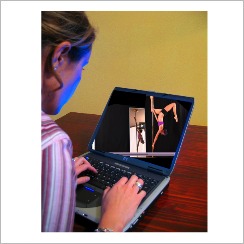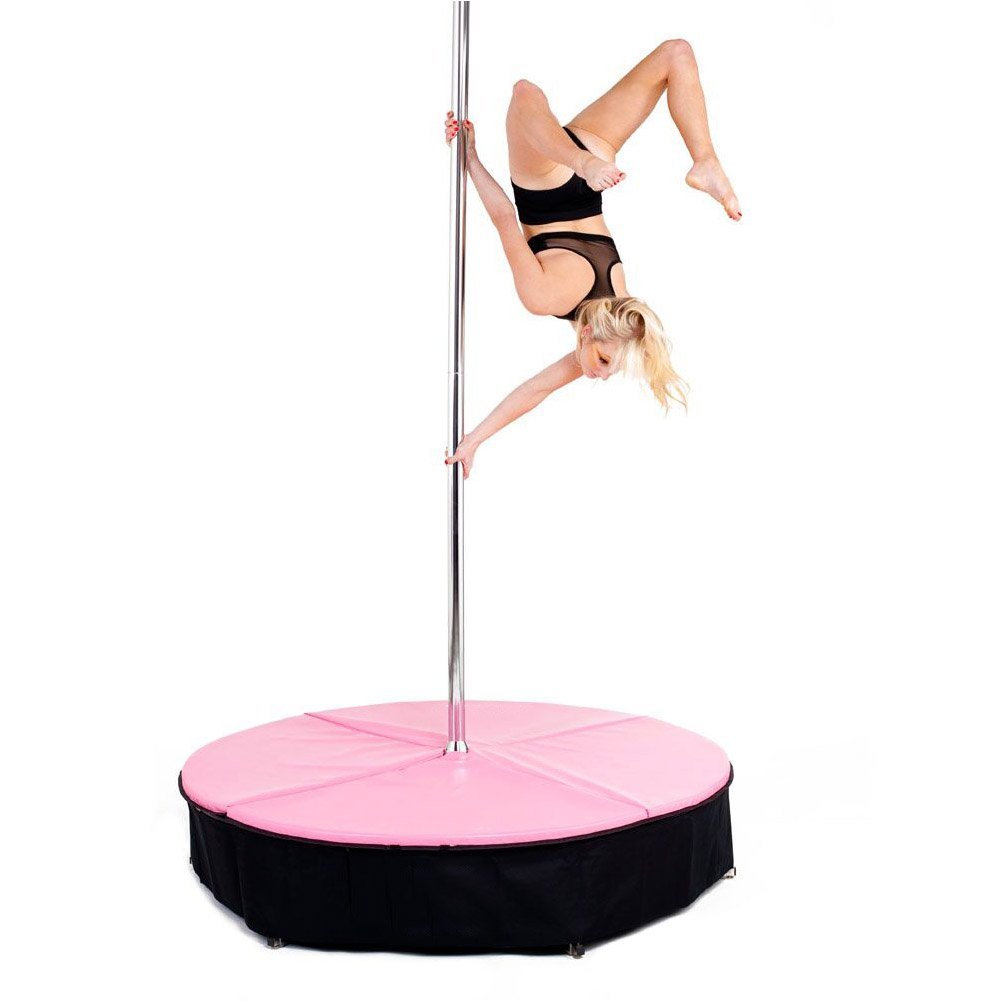Dance Pole Safety - Friction Poles
Home > Pole Types > Friction Fit Poles > Safety
Being aware of dance pole safety is extra important if you have a friction fit pole. While safety should always be a concern, friction poles are - by their design - more likely to come down and cause injury or damage. Your Pole Pal wants you to be safe up there, so she's created this page to make sure you've got the scoop on safety tips specific to friction fit dance poles.
Your Pole Pal says...."Here are the main points you need to know to stay safe. You'll also find more details further down the page."
- Keep in mind that the friction fit design relies entirely on correct installation for safety
- Know and respect the weight limits of your friction mount pole
- Get to know your pole and take the time to build confidence - both with installing and using it - before you progress to more advanced tricks
- Always do a safety check before each use - friction fit poles can and DO loosen with use, so it's important to make sure it's still safe when you want to use it again
- Don't underestimate the importance of ensuring that your friction pole is exactly plumb - if it's not, the chances of it coming down are greatly increased
- If you ever feel unsafe or have doubts while you're using your pole, stop and re-check it for safety - a few minutes of caution is well worth it to avoid the damage and injury that your pole can cause if it comes down!
Click to View a Short Dance Pole Safety Video
on How To Load Test Your Pole
More Friction Dance Pole Safety Info
Your Pole Pal has used friction fit removable stripper poles for some pretty crazy moves with no problems. But then again, she's very strict about dance pole safety because she's also had first hand experience with poles coming down...ouch!
Experience leads to confidence if we learn from our mistakes, but of course safety should be a top priority no matter how much experience or confidence you have.
The tips above, and the information that follows will not guarantee you'll never suffer a mishap, but they can help you understand why dance pole safety is so important, and how to make your friction fit dance pole as safe as possible.
Your Pole Pal says..."Please use this information in conjunction with the manufacturer's installation and safety instructions, and defer to these when in doubt, for maximum safety."
Understanding Friction Dance Pole Safety
The reason that safety with a friction fit pole is such a concern is that, unlike other types of poles, it's not secured in place with screws, bolts or braces.
Instead, friction poles rely entirely on a tight fit between floor and ceiling. That's why it's so critical to get the installation right.
It's also important to gain confidence with the installation process before attempting any potentially dangerous moves on your pole.
Speaking of which, contrary to popular belief, climbs and spins are typically less dangerous in terms of having your pole come down, than moves that put sideways pressure on the lower part of the pole.
Here's a little experiment you can do to help you understand why:
Take a toothpick, a pencil, or any long, thin object and hold it vertically between your index finger and a tabletop. With your other hand, hold the middle of the toothpick between your finger and thumb and give it a wiggle.
Chances are the toothpick remains stable.
Now take that same toothpick and hold it the same way. This time though, gently press sideways against the bottom of the toothpick, near where it rests on the table top.
What will likely happen is that the bottom of the toothpick will slide sideways. Since there's nothing holding it in place at the top other than friction, it doesn't take much sideways pressure to bring it down if it's not tightly wedged in place.
As a result the toothpick, just like your friction mounted dance pole, is going to come down.
Of course, a side load applied anywhere along the length of a
friction fit or removable stripper pole - if it's excessive enough - will
bring it down.
For this reason it's important to know the weight limits of your
friction pole, and also what it is and isn't designed to handle in terms
of side loads, spins, lifts, inversions and other potentially dangerous
moves.
Your Pole Pal's Top Picks For Friction Fit Dance Poles:
The Lil Mynx friction pole comes in a two-piece stainless steel model, and includes either a hard plastic carrying case or a more economical cardboard storage case.
MiPole makes an affordable friction fit pole kit, complete with carrying case.

X-Pole sells a good quality portable, multi-piece friction fit dance pole
Installation & Friction Fit Dance Pole Safety
To really understand these dance pole safety issues, and how to ensure your friction fit pole is installed as safely as possible, let's take a look at a typical installation process.
- First, you measure your floor-to-ceiling height and
then adjust the length of your pole to approximately the same height.
(Note that the exact process for lengthening, and the required length,
varies according to the type of pole. Please refer to the manufacturer's
instructions for exact details.)
- Some friction fit dance poles require
that you place a friction pad on the top and/or bottom of the pole,
while others come with the pad pre-attached. The pole is then placed
vertically in the desired spot, and adjusted so that it will stay in place while you check
for alignment.
Be sure you don't play on your pole just yet...you still need to secure it in place!
- Once the pole is up, it's very important to check to
make sure it's plumb (that means it's straight up and down, and not leaning to one
side or on an angle). This is an extremely important safety step, so
don't skip it!
Checking for plumb can most easily be done with a standard
level. Here's how:
Hold the level vertically along one side of the dance pole, then move a quarter of the way around the pole and check again. Adjust the base of the dance pole by moving it on the floor as required until both sides of the pole show level. Your Pole Pal strongly advises against using a vertical landmark in the room (such as a door frame, a floor lamp or the edge of a picture frame) as these are not guaranteed to be straight unless you also check them with the level.
If all this level business sounds confusing, just think of the pole as having four directions. Check either the north or the south, and the east or the west. It's not necessary to check all 4 directions because east will be the same as west, and north will be the same as south, since they're directly across from each other. - Once you're sure your dance pole is plumb, you can tighten it into place. With an internal spring mechanism, most likely you will turn a smaller inside tube by hand which will lengthen the tube and wedge the pole in place. With an external lock nut system you will turn one nut to extend the pole, then screw down the other nut to lock the extension into place.
Your friction mounted removable pole should now be installed safely, but there's one more thing you should do before you start dancing on your pole...
Load Testing for Safety
To maximize your safety while pole dancing, and to reduce the chances of your dance pole coming down, Your Pole Pal recommends a series of progressive load tests to be sure your pole has been installed as safely as possible.
Here's a short video that shows how to load test a friction fit pole:

Remember, performing the tests shown in the above video won't guarantee that your dance pole won't ever come down, but they can help alert you to any installation issues you need to correct before they become dangerous.
For those who prefer to read rather than watch, here are the steps to take to load test your pole:
- First, push against the dance pole with both hands
at about shoulder height. Give it a good shove to be sure you're being
realistic.
Then work your way down the pole, stepping farther back as you
go lower. The most dangerous spot, as we saw with the toothpick demo, is
at the very bottom.
If the base of the dance pole shifts at all during this test,
adjust the pole so it's plumb again, then tighten it some more and begin
the load test again from the beginning.
- Next, lift yourself up the pole, or climb it, and give it a good shake while you're up there.
This tells you that it's solidly in place against the ceiling.
Of course, be careful NOT to grasp any part of the small extension pole if you have a Lil Mynx pole, as this could
release the tension on the dance pole and bring it down!
- Finally, do a series of spins, starting with something simple that keeps your body weight close to the pole, like the Fireman Spin, and progressing through 3 or 4 spins to one that has your body weight farther away from the pole. Perhaps most important, make sure you stay aware and alert during the load tests. If you feel or notice anything that makes you the least bit uncomfortable, double check to make sure the pole hasn't shifted, then if necessary, tighten it a little more and re-test.
Your Pole Pal says...
"One thing I absolutely insist on if I'm going to be dancing on a friction fit pole, is that I do the installation myself. When it comes to safety, it's kind of like jumping out of an airplane with a parachute on your back.
Ok, so maybe not quite that dangerous. But still, would you just trust that whoever packed your parachute got it right, or would you want to do it yourself so you're sure it's done right?
I rest my case."
As you use your friction fit dance pole more, you'll become more
comfortable with its safe installation and use, though it always pays to
maintain a healthy respect for your dance pole.
Thinking of buying a friction fit dance pole? Be sure to check out this dance pole reviews page for detailed information on all the different brands available.






